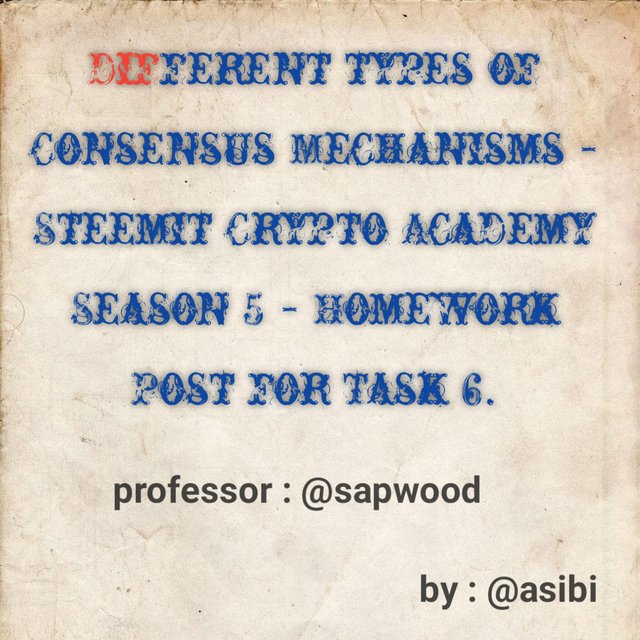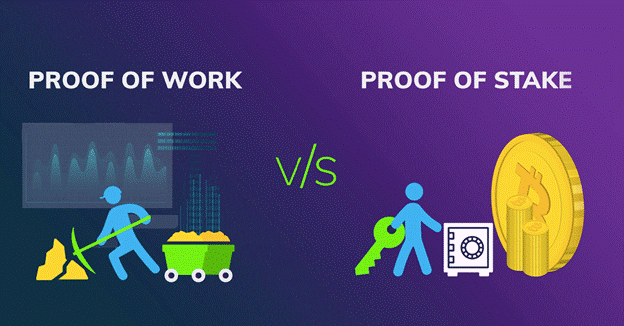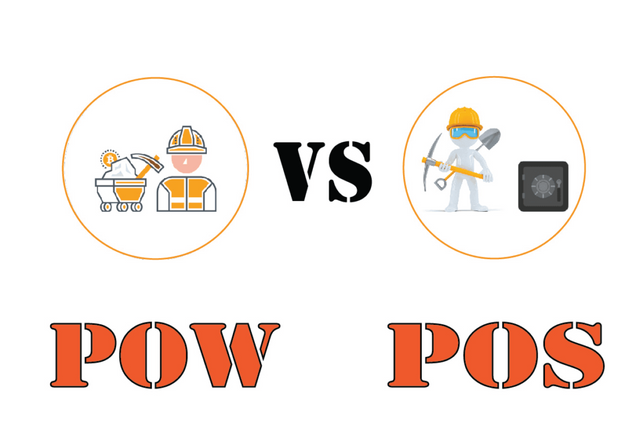Different types of Consensus Mechanisms - Steemit Crypto Academy Season 5 - Homework Post for Task 6.

Hello guys,
Task 6 of the introductory courses introduces us to consensus mechanism used on cryptocurrencies blockchain to determine or validate the next block Miner and also for rewarding block miners. It also focused on the types and examples of consensus mechanisms used on the various types of cryptocurrency blockchains, and how they defer from each other and also their similarities. After going through the class, I have attempted on the questions given base on my understanding and is presented below.
Question 1
What is the difference between PoW & PoS? Advantages & Disadvantages? Which one is better in scaling Capacity? Examples?
Solutions

Source
Before I go ahead to distinguish between Pow and PoS consensus mechanisms, let's look at what consensus mechanisms are and the reason why these mechanisms are important to every blockchain. As the name implies, consensus which means to come to a single view or agreement.
You see that in every centralized system, the system is controlled and managed by a single body, meaning that power and authority are concentrated in a single body to control the entire system. Therefore, changes and decisions can be effected on the entire system at anytime they want without having to pass through any complex procedures or system in order to come into a consensus among administrators or leaders. But when it comes to the decentralized system, everything changes, because the way to come into a consensus on a blockchain is entirely different. On a decentralized system, we are operating with a large digital ledger or database that is duplicated, on what bases can we come to a consensus as to what information should be added or not added to the database? Consensus mechanisms are established on every blockchain to address this challenges.
So therefore, consensus mechanisms are well established computer codes or network among nodes on the blockchain so as to maintain the identical copy of the database in order not to undermine the integrity and essence of the cryptocurrency network as a result of conflicting information. This mechanism on the blockchain is used to validate and confirm blocks and transactions, it is also used as the reward system on the blockchain.
They are some well known consensus mechanisms used by different blockchains, these include, Proof of Work (PoW), Proof of Stake (PoS), Delegated Proof of Stake (DPoS), Proof of Capacity (PoC), Proof of Burn (PoB), Proof of Activity (PoA), Proof of Brain (PoB) etc. For the sake of this assignment, I will be focusing on PoW and PoS.
a) What is the difference between PoW & PoS?

Source
What is PoW
PoW mechanisms is simply the type of mechanism where users or miners are expected to solve a complex mathematical puzzle inorder to qualify or win the right to mine the next block on the blockchain. A block is simply a box or folder containing information about a particular transaction initiated on the blockchain. When a Miner is tasked to mine a block after successfully solving the puzzle on time, they are tasked to record, verify and validate that transaction, miners get rewarded for mining a block. PoW requires a lot of computer power and electricity, hence it is seen as not being energy efficient. Some projects that uses the PoW mechanisms are bitcoin and ethereum
What is PoS
The PoS on the other hand selects a Miner to mine the next block base on the proportion of investment in the native coin on the platform they have, increasing your stake or investment on the platform gives you the chance to be awarded to verify and validate the next block. Unlike the PoW, the PoS do not required any expensive and high quality computer soft ware, hence it is less expensive and energy efficient. This mechanism also helps to give the native coin much value because of constantly investing and locking large proportion of the coin on the platform. Some projects that uses this mechanism include, tron, Algorand, and Tezos.
Summary of differences between PoW & PoS
| PoW | PoS |
|---|---|
| It is not energy efficient since it uses high and expensive computer gadgets and electricity. | it is energy efficient since it only base on increasing your stake on the platform and do not require expensive computer hard ware and electricity. |
| Miners have to solved complex mathematical puzzles. | Miners have to constantly increase their stake on the platform. |
| It is very expenssive to use this system. | It is less expensive to use this system. |
| This system is randomized in selecting miners. | This system tend to be more centralized in selecting miners. |
| Example of projects using this system include bitcoin and ethereum. | Example of projects using system include Tron and Tezos. |
b)Advantages & Disadvantages?
Proof of Work (PoW)
| Advantages | Disadvantages |
|---|---|
| The PoW mechanism gives the chance to every miner to be able to mine once they solve the puzzle first because of how randomly it is in selecting miners. | It is very expenssive to mine because of the expenssive computer hardware needed and the amount of electricity needed. |
| PoW quarantee mining rewards to miners after creating a block. Miners receive native coins on the blockchain when they verify and validate a transaction. | Miners have to used a lot of computation power and skills in order to qualify to mine a block. This causes a lot of challenges for some miners since it required a lot of brain usage and stress. |
| PoW uses a more decentralized approach in verifying and validating transactions, it doesn't favour some particular group of people on the platform who tend to have much influence on the platform, rather, everyone has an equal chance to mine the next block. | It consumes a lot energy, it requires a very high energy usage inorder to solve a puzzle because of the supercomputer required. |
| PoW mechanism was the first to be developed, hence it is very popular and it is used by top cryptocurrencies blockchain like bitcoin and ethereum. | PoW is very vulnerable to notorious attacks, because of the use of powerful supercomputers, miners can easily manipulate the system and again dominance undermining the idea of decentralization. |
| There is high level of security in the proof of Work (PoW) consensus. The mechanism make it very difficult to change any part of the database, hence ensuring authenticity. | There is slow transaction speed and high charges of fee or expensive fees, because of the high cost associated with rounding this system, it has scalability limitations which slow the speed of transaction. |
Proof of Stake (PoW)
| Advantages | Disadvantage |
|---|---|
| PoS is more energy efficient since it doesn't require any supercomputers to solve any mathematical puzzles, rather, the system only requires miners to increase their stake by freezing a proportion of their earnings in order to increase their chances of mining the next block. | One problem of the PoS is that, it is not readily accessible. This is because one have to own a native coins of the blockchain in order to increase his stake and the technicality involve in owing a coin deter individuals. |
| PoS also makes the blockchain very secure, it gives incentives to miners who does proper validation and disincentivizing improper ones. Validators earn a proportion of the fee and they will also lose if they confirm fraudulent transactions. | Also, the PoS system makes the rich get richer and the poor get poorer, because the more a Miner can buy the native coin to increase his stake the better chance he has to create a block, so the more one can afford to buy cryptocurrencies, the more they can earn cryptocurrencies. |
| The PoS is more scalable as compare to the PoW mechanism, because it doesn't require any expensive computer to mine a new block, the blockchain is more scalable. | Because PoS seems to be a new system, it level of security is questionable as compare to PoW. |
| This mechanism helps in price dynamic of the native cryptocurrency since always there is a proportion of the coin frozen on the platform. | The PoS is susceptible to what is called 51 % attack, this is when a group of miners come together and decide to create a resource pool in order to create monopoly, they will control more than 50% of the mining right which undermines the idea of decentralization. |
| The PoS ensures ecological well being, since there is no need to use huge amount of electricity to mine, it helps to avoid huge electrical Waves saturating the atmosphere. | The fact that holding so much coins indicates that those coins can't not be traded with and are not useful to the miner hence can't be use as payment. |
c) Which one is better in scaling Capacity? Examples?

Source
Scalability on a blockchain is how many transactions can be process in a second, this is a problem confronted by blockchains as a result of constant increase in the blocks due to several transactions, scalability has been a problem and several suggestions which include better consensus mechanisms, sharding and nested blockchain has been suggested to address the problem of scalability. Improving consensus protocols has been recommended to solve this problem, and the PoS system stands a good chance of solving blockchain scalability problem since it doesn't require miners to solve any cryptography algorithms by using supercomputers. So PoS is more better in scalability.
Examples
- Algorand (ALGO): Algorand is a decentralized blockchain base network that can manage a large number of application and it is more scalable and efficient with the ability to process almost 1000 transactions per second with approximately 5 seconds ledger close time.
- Cardano (ADA): ADA is an open source decentralized blockchain that gives it users the total right and help create a society of transparency and fairness. It has the ability to process up to 257 transactions per second.
- Ripple (XRP): XRP is an open source decentralized blockchain which is less costly, speedy, and more scalable. It's core use is base on payment. XRP has the ability to process up to 1500 transactions per second.
- Celo (CELO): This is a blockchain that uses phone numbers as it public keys in an attempt to increase the adaption of cryptocurrencies on smart phones. It has the ability to process up to 1000 transactions per second and a ledger close time of 5 seconds.
Other examples that can be also looked at include stellar lumens, Solana, etc.
Conclusion
The blockchain as a futuristic technical innovation is accepted not only for financial operations, but some technical and I T companies have also embraced it because of its decentralized system and many DApps are established on the blockchains to run businesses. Scalability might be a major problem going into the future of blockchain because of the constant increase in the number of users and transactions. Players should put in place a strategically plan to solve this problem, and I think improving the consensus mechanisms of blockchains will help solve this scalability problem.
Thanks to professor @sapwood for this wonderful class, I have really learnt a lot.
Thank you
Sort: Trending
Loading...